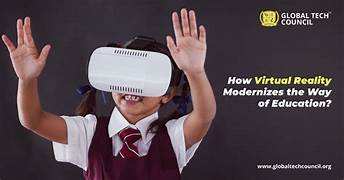Can Virtual Reality Transform the Way We Approach Education?
Education has always evolved with technology, from chalkboards to interactive whiteboards, and now to virtual reality (VR). Virtual reality, once the realm of gaming and entertainment, is increasingly finding its way into classrooms, training programs, and educational institutions. By creating immersive, interactive, and engaging environments, VR has the potential to revolutionize the way we learn and teach.
This article explores the transformative impact of virtual reality on education, its benefits, challenges, and future possibilities.
The Essence of Virtual Reality in Education
Virtual reality is a technology that creates a simulated environment where users can interact with 3D worlds. In education, VR enables students to step into scenarios that would otherwise be inaccessible due to physical, financial, or safety constraints. For example, students can explore the surface of Mars, perform complex surgeries, or witness historical events—all from their classroom.
The ability to make abstract concepts tangible and theoretical knowledge experiential lies at the heart of VR’s transformative potential in education.
Applications of VR in Education
1. Enhanced Engagement and Immersion
VR captivates students by immersing them in lessons that feel like real-life experiences. Traditional teaching methods can sometimes struggle to maintain attention, but VR’s interactivity fosters active participation. For instance:
- History students can “walk through” ancient civilizations like Rome or Egypt.
- Biology students can explore the human body at a molecular level.
- Literature students can experience scenes from novels as if they were characters in the story.
2. Science, Technology, Engineering, and Mathematics (STEM)
STEM fields are ideal for VR integration, as they often involve abstract concepts that benefit from visual and hands-on exploration. For example:
- Physics experiments involving complex machinery can be simulated in VR, reducing costs and risks.
- Engineering students can design, test, and manipulate 3D models of structures in virtual environments.
- Medical students can practice surgical procedures using VR simulations, enhancing their skills without endangering patients.
3. Virtual Field Trips
Field trips are invaluable for experiential learning, but logistical and financial constraints often limit their feasibility. VR offers an alternative:
- Students can visit landmarks like the Great Wall of China or the Amazon Rainforest without leaving their school.
- Museums and cultural sites offer VR tours, bringing art, history, and science exhibits directly to classrooms.
4. Personalized Learning
VR supports adaptive learning by allowing students to progress at their own pace. Customizable virtual environments can cater to individual learning styles, making education more inclusive:
- Students struggling with a topic can revisit VR modules until they master the material.
- Advanced learners can explore more challenging content, staying motivated and engaged.
5. Special Education
For students with disabilities, VR provides opportunities to experience activities that might otherwise be inaccessible:
- Mobility-impaired students can explore virtual parks or cities.
- VR can simulate social situations for students with autism, helping them develop interpersonal skills in a controlled setting.
6. Corporate and Vocational Training
Beyond traditional education, VR is transforming professional training:
- Companies use VR to train employees in high-stakes fields like aviation, construction, and healthcare.
- Vocational schools incorporate VR simulations to teach technical skills without the risk of accidents or resource wastage.
Benefits of VR in Education
1. Experiential Learning
VR turns passive learning into active exploration. Instead of reading about concepts, students experience them firsthand, deepening comprehension and retention.
2. Safe and Controlled Environment
In VR, students can experiment without fear of failure or danger:
- Chemistry students can mix volatile compounds safely.
- Aspiring pilots can practice maneuvers in flight simulators without real-world risks.
3. Breaking Geographical Barriers
VR connects classrooms across the globe, enabling cultural exchange and collaborative projects:
- Students in different countries can work together in shared virtual spaces.
- Teachers can invite guest lecturers to VR classrooms, regardless of location.
4. Cost-Effectiveness
While initial investment in VR hardware can be high, it reduces long-term costs:
- Virtual labs eliminate the need for expensive equipment and consumables.
- Field trips become affordable and accessible to all students.
5. Motivation and Engagement
VR’s gamified approach to learning keeps students motivated. Achievements, challenges, and interactive feedback make learning enjoyable and rewarding.
Challenges of Implementing VR in Education
1. High Initial Costs
VR headsets, software, and infrastructure can be prohibitively expensive for many schools, especially in underfunded regions. The cost of maintaining and updating VR equipment adds to the financial burden.
2. Accessibility Issues
Not all students have access to VR technology, creating a digital divide. Ensuring equitable access is a critical challenge for educators and policymakers.
3. Health Concerns
Prolonged use of VR can cause motion sickness, eye strain, and discomfort. Educators must carefully balance the use of VR with traditional teaching methods to avoid overexposure.
4. Training and Support
Teachers require training to integrate VR effectively into their curriculum. Without proper support, the potential of VR can remain untapped.
5. Content Limitations
While VR offers immense possibilities, creating high-quality, curriculum-aligned content is time-consuming and costly. Limited content availability can restrict VR’s utility in education.
Future Prospects of VR in Education
Despite its challenges, the future of VR in education is bright, with advancements in technology and growing investment in edtech. Here’s what the future might hold:
1. Greater Affordability
As VR technology becomes more mainstream, costs are likely to decrease, making it accessible to more schools and institutions.
2. Integration with Artificial Intelligence (AI)
AI-driven VR systems can offer personalized learning experiences by adapting to each student’s pace, preferences, and performance.
3. Expansion of Content Libraries
The growth of VR content libraries will ensure that diverse subjects and curriculums are represented, catering to students of all ages and disciplines.
4. Hybrid Learning Models
VR can complement traditional and online learning, creating a blended approach that combines the best of all methods.
5. Collaborative Virtual Classrooms
Future VR platforms may allow students and teachers to interact in shared virtual classrooms, fostering collaboration and a sense of community.
Conclusion
Virtual reality has the potential to transform education by making learning more immersive, engaging, and accessible. From virtual field trips and STEM simulations to personalized learning and vocational training, VR opens doors to new possibilities that traditional methods cannot achieve.
However, the journey toward widespread adoption is not without obstacles. High costs, accessibility issues, and the need for quality content and training remain significant challenges. Addressing these concerns requires collaboration among educators, policymakers, technologists, and businesses.
As VR technology evolves and becomes more affordable, its impact on education will likely grow, shaping a future where learning is not confined to classrooms but spans virtual worlds. The question is not whether VR can transform education but how quickly we can overcome its barriers to unlock its full potential.


